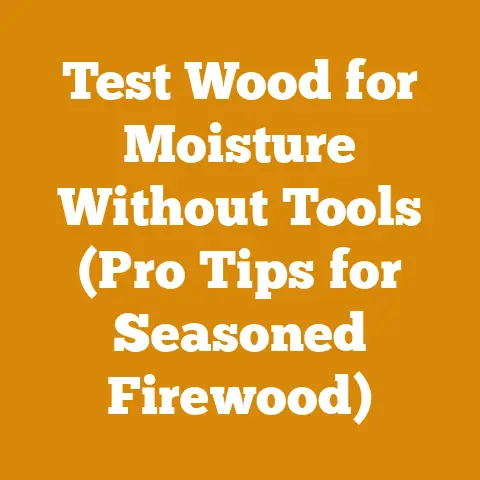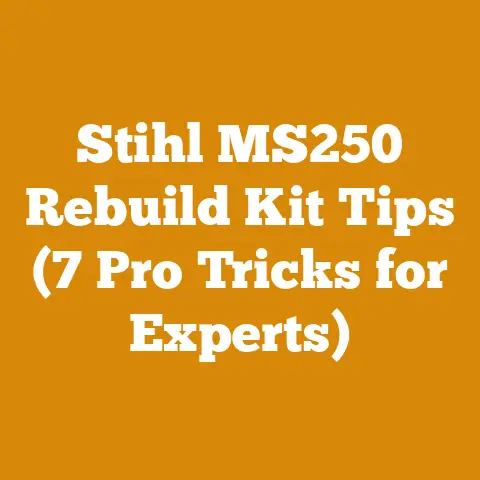Pellet Stove Smells Like Smoke? (5 Proven Wood Prep Fixes)
“The best laid schemes o’ Mice an’ Men, Gang aft agley,” wrote Robert Burns.
And while he was pondering the fickleness of fate, I’d wager a rusty wedge he never wrestled with a pellet stove spewing smoky odors.
A pellet stove should be a bastion of clean, efficient heat.
But when it smells like smoke – well, that’s a problem.
It’s a sign that something is amiss in the delicate balance of combustion and venting.
More often than not, the culprit lurks in the very fuel you’re feeding it: the wood pellets themselves, or rather, the preparation (or lack thereof) of the wood that comprises them.
Pellet Stove Smells Like Smoke? (5 Proven Wood Prep Fixes)
A smoky pellet stove isn’t just an annoyance; it’s a potential health hazard and a sign of inefficiency.
Before you start suspecting mechanical failures or faulty installations, let’s examine the foundation of your stove’s performance: the wood pellets.
Poorly prepared wood, even in pellet form, can lead to incomplete combustion, excessive ash buildup, and, yes, that acrid smoky smell.
Here are five proven fixes, each addressing a crucial aspect of wood preparation:
1. Source High-Quality Pellets: Know Your Wood
The golden rule of pellet stove operation is, “Garbage in, garbage out.” The quality of your pellets directly impacts the stove’s performance.
But what constitutes “high-quality”?
It boils down to the wood species used, the manufacturing process, and the storage conditions.
Wood Species Matter: Hardwood pellets (oak, maple, hickory) generally burn hotter and cleaner than softwood pellets (pine, fir).
Hardwoods have a higher density, resulting in more energy per pound.
However, some softwood pellets are specifically designed for pellet stoves and can perform well if properly manufactured.
I’ve personally found that oak pellets offer the most consistent heat output and leave the least amount of ash in my stove.- Cost Implications: Hardwood pellets typically cost more than softwood pellets.
Expect to pay anywhere from $250 to $400 per ton for hardwood pellets, compared to $200 to $300 per ton for softwood.
While the upfront cost is higher, the increased efficiency can offset the difference in the long run. - Manufacturing Process: Look for pellets certified by the Pellet Fuels Institute (PFI).
This certification ensures that the pellets meet specific standards for ash content, moisture content, and BTU output.
I always check the PFI stamp of approval before buying pellets, as it gives me peace of mind knowing that they’ve been tested and meet industry standards. -
Storage Conditions: Pellets are hygroscopic, meaning they readily absorb moisture from the air.
Even the slightest increase in moisture content can significantly reduce their heating value and increase smoke production.
Always store pellets in a dry, well-ventilated area.
I learned this the hard way when I left a bag of pellets outside during a rainstorm.
They turned into a soggy mess and were completely unusable. -
Cost Implications: Proper storage requires an initial investment in airtight containers or a dedicated storage shed.
A large plastic storage bin can cost around $50 to $100, while a small shed can range from $500 to $2000.
However, this investment will protect your pellets from moisture damage and save you money in the long run by preventing waste.
- Cost Implications: Hardwood pellets typically cost more than softwood pellets.
Data Points:
- The Pellet Fuels Institute (PFI) sets industry standards for pellet quality.
Look for the PFI certification mark on pellet bags. - According to the U.S.
Energy Information Administration (EIA), the average price of wood pellets varies by region, with the Northeast generally having the highest prices. - A study by the University of Maine found that hardwood pellets have a higher BTU output per pound than softwood pellets, resulting in more efficient heating.
Cost Breakdown (per ton):
Actionable Steps:
- Research different pellet brands and read reviews to find the best quality pellets in your area.
- Look for pellets with low ash content (ideally less than 1%).
- Always store pellets in a dry, airtight container.
2. Reduce Moisture Content: The Dry Wood Doctrine
Even high-quality pellets can cause smoke if they’ve absorbed moisture.
Moisture hinders efficient combustion, leading to incomplete burning and increased smoke.
The ideal moisture content for wood pellets is below 8%.
- Testing Moisture Content: A moisture meter is an invaluable tool for determining the moisture content of your pellets.
These devices are relatively inexpensive and easy to use.
I use a simple pin-type moisture meter to check the moisture content of my pellets before loading them into the stove. - Drying Damp Pellets: If your pellets are damp, you can try drying them out before using them.
Spread them out in a thin layer in a warm, dry place, such as a garage or shed.
You can also use a dehumidifier to speed up the drying process. Preventative Measures: The best way to prevent moisture problems is to store your pellets properly.
Keep them in airtight containers and avoid storing them in damp or humid areas.- Cost Implications: A basic moisture meter costs around $20 to $50.
A dehumidifier can range from $100 to $300.
The cost of drying damp pellets is primarily the cost of electricity to run the dehumidifier.
- Cost Implications: A basic moisture meter costs around $20 to $50.
Data Points:
- The ideal moisture content for wood pellets is below 8%.
- Moisture meters can accurately measure the moisture content of wood pellets.
- Proper storage is essential for preventing moisture absorption.
Calculation:
- Estimated Drying Time: The drying time for damp pellets depends on the ambient temperature, humidity, and airflow.
A rough estimate is that it can take several days to a week to dry out damp pellets in a warm, dry environment.
Actionable Steps:
- Invest in a moisture meter to test the moisture content of your pellets.
- If your pellets are damp, dry them out before using them.
- Store your pellets properly to prevent moisture absorption.
3. Adjust Stove Settings: Fine-Tune the Flame
Pellet stoves are designed to burn pellets efficiently, but they require proper adjustments to achieve optimal performance.
The air-to-fuel ratio is crucial for complete combustion.
Too little air, and the pellets will smolder, producing smoke.
Too much air, and the fire will burn too hot, wasting fuel.
- Consult Your Manual: The owner’s manual for your pellet stove provides specific instructions on how to adjust the air-to-fuel ratio.
Follow these instructions carefully. - Observe the Flame: A healthy pellet stove flame should be bright yellow and dancing.
A smoky, orange flame indicates incomplete combustion and insufficient air. Experiment with Settings: Don’t be afraid to experiment with the stove settings to find the optimal combination for your pellets and your home’s heating needs.
I’ve spent hours tweaking the settings on my pellet stove to find the sweet spot where it burns cleanly and efficiently.- Cost Implications: Adjusting stove settings is essentially free, but it requires time and patience.
The cost of experimenting with different settings is the cost of the pellets you use during the process.
- Cost Implications: Adjusting stove settings is essentially free, but it requires time and patience.
Data Points:
- The air-to-fuel ratio is crucial for complete combustion in a pellet stove.
- A healthy pellet stove flame should be bright yellow and dancing.
- The owner’s manual provides specific instructions on how to adjust the stove settings.
Actionable Steps:
- Consult your owner’s manual for instructions on adjusting the air-to-fuel ratio.
- Observe the flame and adjust the settings accordingly.
- Experiment with different settings to find the optimal combination for your pellets and your home’s heating needs.
4. Regular Cleaning and Maintenance: A Clean Sweep to Success
Ash buildup is a common cause of smoky pellet stoves.
Ash restricts airflow, hindering combustion and leading to incomplete burning.
Regular cleaning and maintenance are essential for preventing ash buildup and ensuring optimal performance.
- Daily Cleaning: Empty the ash pan daily, or as needed, depending on the amount of ash produced.
- Weekly Cleaning: Clean the burn pot and heat exchanger tubes weekly.
Use a brush or vacuum to remove ash and debris. Annual Cleaning: Perform a thorough cleaning of the entire stove at least once a year.
This includes cleaning the venting system and inspecting all components for wear and tear.
I usually hire a professional to clean my pellet stove annually, as they have the tools and expertise to do a thorough job.- Cost Implications: Cleaning supplies, such as brushes and vacuums, cost around $20 to $50.
Hiring a professional to clean your pellet stove annually can cost anywhere from $100 to $300.
- Cost Implications: Cleaning supplies, such as brushes and vacuums, cost around $20 to $50.
Data Points:
- Ash buildup restricts airflow and hinders combustion.
- Regular cleaning and maintenance are essential for preventing ash buildup.
- Professional cleaning ensures a thorough job and can identify potential problems.
Actionable Steps:
- Empty the ash pan daily.
- Clean the burn pot and heat exchanger tubes weekly.
- Perform a thorough cleaning of the entire stove at least once a year.
5. Venting System Inspection: Smoke Signals and Solutions
A properly functioning venting system is crucial for removing exhaust gases from your home.
A blocked or damaged venting system can cause smoke to back up into your home.
- Inspect the Venting System Regularly: Check the venting system for any signs of blockage or damage.
Look for cracks, leaks, or obstructions. - Clean the Venting System Annually: Clean the venting system annually to remove ash and debris.
This can be done with a chimney brush or a specialized venting system cleaning kit. Ensure Proper Installation: Make sure the venting system is properly installed according to the manufacturer’s instructions.
Improper installation can lead to airflow problems and smoke leakage.
I once had a pellet stove installed by a contractor who didn’t properly seal the vent pipe.
The result was a smoky mess and a costly repair.- Cost Implications: A chimney brush or venting system cleaning kit costs around $30 to $50.
Hiring a professional to inspect and clean your venting system can cost anywhere from $100 to $300.
- Cost Implications: A chimney brush or venting system cleaning kit costs around $30 to $50.
Data Points:
- A blocked or damaged venting system can cause smoke to back up into your home.
- Regular inspection and cleaning are essential for maintaining a properly functioning venting system.
- Proper installation is crucial for preventing airflow problems and smoke leakage.
Actionable Steps:
- Inspect the venting system regularly for any signs of blockage or damage.
- Clean the venting system annually to remove ash and debris.
- Ensure proper installation according to the manufacturer’s instructions.
The Economics of Wood Prep: A Deep Dive into Costs
Now that we’ve covered the five wood prep fixes, let’s delve into the economics of wood preparation.
Understanding the costs involved in sourcing, processing, and storing wood pellets is crucial for making informed decisions and budgeting effectively.
Sourcing Pellets: Purchase vs. Production
The first decision you’ll face is whether to purchase commercially produced pellets or attempt to produce your own.
While producing your own pellets might seem appealing, it’s generally not cost-effective for homeowners due to the high cost of pelletizing equipment.
I briefly entertained the idea of making my own pellets, but the equipment costs were prohibitive.
- Commercial Pellets: Purchasing commercially produced pellets is the most common and convenient option.
As mentioned earlier, prices vary depending on the wood species, quality, and location. - Home Production: Producing your own pellets requires specialized equipment, such as a pellet mill, which can cost several thousand dollars.
The cost of raw materials (sawdust, wood chips) also needs to be factored in.
Cost Comparison:
Data Points:
- Pellet mills can cost anywhere from $5,000 to $20,000 or more.
- The cost of raw materials for pellet production varies depending on the availability and price of sawdust and wood chips.
- The labor cost for home pellet production can be significant, depending on the amount of time spent sourcing materials and operating the equipment.
Material Costs: Species, Quality, and Quantity
The cost of wood pellets is directly influenced by the wood species used, the quality of the pellets, and the quantity you purchase.
- Wood Species: Hardwood pellets are generally more expensive than softwood pellets due to their higher density and BTU output.
- Pellet Quality: Premium pellets with low ash content command a higher price than standard pellets.
- Quantity Discounts: Purchasing pellets in bulk (e.g., by the ton) typically results in lower prices per bag.
I always try to buy my pellets in bulk at the end of the heating season when prices are typically lower.
Cost Factors:
- Transportation Costs: The cost of transporting pellets from the supplier to your home can be significant, especially if you live in a remote area.
- Storage Costs: As mentioned earlier, proper storage requires an initial investment in airtight containers or a dedicated storage shed.
- Waste: Improper storage or handling can lead to pellet damage and waste, which increases the overall cost.
Actionable Steps:
- Compare prices from different suppliers to find the best deals.
- Consider purchasing pellets in bulk to take advantage of quantity discounts.
- Factor in transportation and storage costs when budgeting for wood pellets.
Labor Costs: DIY vs. Professional Help
While pellet stove operation is generally a DIY activity, there are times when professional help is needed, such as for annual cleaning or repairs.
- DIY Maintenance: Performing routine maintenance tasks, such as emptying the ash pan and cleaning the burn pot, is relatively easy and can save you money on labor costs.
- Professional Cleaning: Hiring a professional to clean your pellet stove annually ensures a thorough job and can identify potential problems that you might miss.
- Repairs: If your pellet stove breaks down, it’s best to hire a qualified technician to diagnose and repair the problem.
Attempting to repair the stove yourself without the necessary knowledge and expertise can be dangerous.
Cost Breakdown:
Actionable Steps:
- Perform routine maintenance tasks yourself to save money on labor costs.
- Consider hiring a professional for annual cleaning to ensure a thorough job.
- Hire a qualified technician for repairs to avoid potential safety hazards.
Tool Costs: Essential Equipment for Pellet Stove Owners
While pellet stoves don’t require a lot of specialized tools, there are a few essential items that every owner should have on hand.
- Moisture Meter: A moisture meter is essential for checking the moisture content of your pellets.
- Ash Vacuum: An ash vacuum is designed specifically for cleaning up ash and debris from pellet stoves.
- Cleaning Brushes: Cleaning brushes are used to clean the burn pot and heat exchanger tubes.
- Gloves: Gloves protect your hands from ash and debris.
Cost Breakdown:
Actionable Steps:
Step 1: Estimate Your Heating Needs
The first step is to estimate your heating needs.
This will depend on the size of your home, the climate you live in, and your desired indoor temperature.
A general rule of thumb is that one ton of pellets will heat an average-sized home for one heating season.
- BTU Calculation: Calculate the total BTU (British Thermal Unit) output required to heat your home.
This can be done using online calculators or by consulting with a heating professional. - Pellet Consumption: Estimate the amount of pellets you’ll need based on the BTU output of your stove and the BTU content of the pellets you’re using.
Step 2: Calculate Pellet Costs
Once you know how many pellets you’ll need, you can calculate the total cost.
- Price per Ton: Determine the price per ton of the pellets you’re planning to use.
- Total Pellet Cost: Multiply the price per ton by the number of tons you’ll need.
Step 3: Estimate Maintenance Costs
Next, estimate your maintenance costs.
- Cleaning Supplies: Factor in the cost of cleaning supplies, such as brushes and vacuums.
- Professional Cleaning: If you plan to hire a professional for annual cleaning, include that cost in your budget.
- Repairs: Set aside a contingency fund for potential repairs.
Step 4: Factor in Tool Costs
Include the cost of any essential tools you’ll need.
- Moisture Meter: Include the cost of a moisture meter.
- Ash Vacuum: Include the cost of an ash vacuum.
Step 5: Total Budget
Add up all the costs to arrive at your total budget for pellet stove operation.
Sample Budget:
Actionable Steps:
- Estimate your heating needs accurately.
- Shop around for the best prices on pellets.
- Factor in all maintenance and tool costs.
- Set aside a contingency fund for potential repairs.
Cost Optimization Strategies: Saving Money on Wood Prep
Finally, let’s explore some cost optimization strategies to help you save money on wood preparation and pellet stove operation.
- Buy in Bulk: As mentioned earlier, purchasing pellets in bulk typically results in lower prices per bag.
- Shop Around: Compare prices from different suppliers to find the best deals.
- DIY Maintenance: Perform routine maintenance tasks yourself to save money on labor costs.
- Proper Storage: Proper storage prevents pellet damage and waste, which reduces the overall cost.
- Energy Efficiency: Improve the energy efficiency of your home by sealing drafts and adding insulation.
This will reduce your heating needs and lower your pellet consumption. - Government Incentives: Check for government incentives or rebates for pellet stove owners.
Many states and municipalities offer financial assistance to encourage the use of renewable energy sources.
Actionable Steps:
- Implement cost optimization strategies to save money on wood preparation and pellet stove operation.
- Take advantage of government incentives and rebates.
- Continuously monitor your costs and adjust your budget as needed.
Conclusion: Smoke-Free Success and Sustainable Savings
A smoky pellet stove is a frustrating problem, but it’s often a problem with a solution rooted in proper wood preparation.
By sourcing high-quality pellets, reducing moisture content, adjusting stove settings, maintaining your stove diligently, and ensuring proper venting, you can banish the smoke and enjoy the clean, efficient heat your pellet stove was designed to provide.
Moreover, by understanding the economics of wood preparation and implementing cost optimization strategies, you can save money and make your pellet stove a sustainable and affordable heating option.
It’s about being proactive, staying informed, and embracing the principles of efficient fuel management.
So, go forth, prepare your wood wisely, and let your pellet stove be a source of warmth and comfort, not smoky frustration.
After all, a penny saved on proper wood prep is a penny earned towards a cozy, smoke-free winter!






